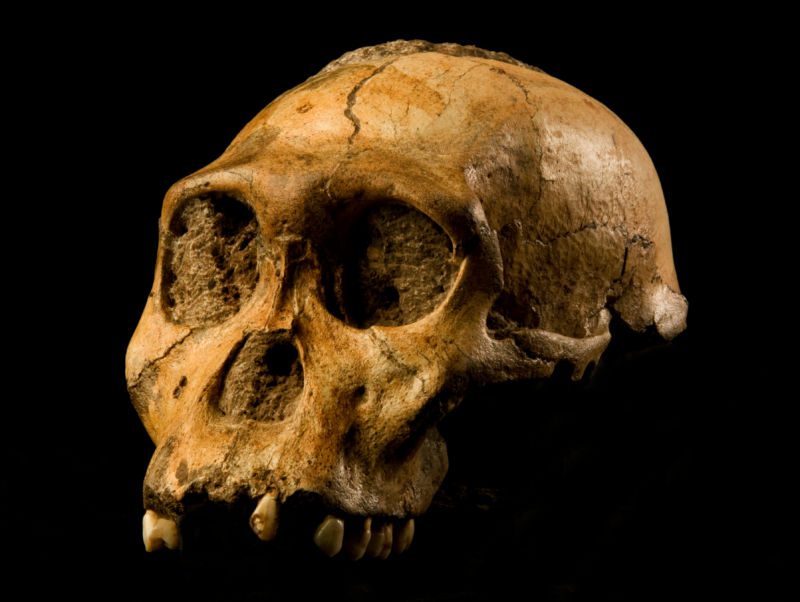We probably don’t descend from Australopithecus sediba
There's less than a 1% chance Australopithecus sediba led to the genus Homo.

Enlarge / According to Du and Alemseged, A. sediba is probably not our direct ancestor.
Where did we come from?
Os principais candidatos incluem uma espécie chamada Australopithecus sediba, conhecida a partir dos restos fossilizados de dois adultos e quatro crianças que aparentemente morreram na caverna de Malapa há cerca de 1,9 milhões de anos. O outro contendor de topo é chamado A. afarensis, mais conhecido do esqueleto de 3,2 milhões de anos, apelidado de Lucy e um conjunto de pegadas preservadas perto de Laetoli, na Tanzânia.Ambas as espécies andaram sobre duas pernas e provavelmente fizeram ferramentas de pedra, mas seus ombros, braços e mãos também foram construídos para subir em árvores. Então, qual espécie é, na verdade, nossa ancestral e que é apenas uma prima distante?
“Knowing which species gave rise to Homo is important in its own right,” University of Chicago Paleoanthropologist Andrew Du told Ars Technica. “That is, it directly addresses the question of where we came from, which is of interest to all humans.” Understanding which species produced our lineage, and when and where that happened, could tell us some important things about the environments, selective pressures, and adaptive abilities that shaped us.
Alas, there’s no Pliocene version of Jerry Springer waiting in the wings with a DNA test; the fossils are so old, in fact, that recovering DNA hasn’t been possible. To try to figure out the relationships, paleoanthropologists have to look at how skeletons have changed and try to trace a path from one set of features to the next. That’s challenging enough, but the fossil record seems to preserve only around seven percent of the primate species that have ever lived, including hominins, and the record is especially spotty from around 3 to 2.5 million years ago. It’s easy to see why there’s so much debate.
One species has an alibi
If we’re going to claim a species as our ancestor, the relationships also have to make chronological sense. You’d expect a species to be older than its descendants, unless somebody finds Dr. Strange’s fingerprints in the next rock formation over. But evolution is complicated, and it’s possible for a species to split into two evolutionary branches (the fancy scientific term for this is "budding cladogenesis”). In that case, the original species could survive well after the branching point, so you could find fossils from that species that are actually younger than members of the species that branched off.Some paleoanthropologists argue that’s what happened with A. sediba and the first members of Homo. The only known fossils of A. sediba came from a 1.97 million-year-old layer of rock at a single site at Malapa, South Africa—about 0.8 million years younger than the earliest fossil that seems to clearly fit into our genus, Homo (a 2.8 million-year-old jawbone).
While it’s technically possible for evolution to create this pattern, is it actually likely? If you put a bunch of fossils in a bag and start pulling them out at random, what are the odds that the first fossil you would draw from one species would be 800,000 years younger than the first fossils of a species that “budded” from it? That’s the question Du and co-author Zeresenay Alemseged put to the test.
They turned to the hominin fossil record and plotted the ages of the
first fossils discovered from 28 pairs of species and their descendants.
It’s worth mentioning that the first fossil from the ancestor species
was older than the first fossil from the descendant species in just one
case: Homo erectus and its proposed descendant H. antecessor. The gap there was only about 0.1 million to 0.2 million years.
In fact, Du and Alemseged calculated that, if a species lived for
roughly 0.97 million years (an average calculated by a 2016 study), the
odds of a fossil specimen being 0.8 million years younger than its
alleged descendant were about 0.9 percent. If you’re a statistics buff,
that means that if you plot the observed difference in age between
fossils on a bell curve, the 0.8-million-year gap between A. sediba and the earliest Homo is hanging out on the far right tail of the curve. While it’s still technically possible for A. sediba to be the proud ancestor of our genus, it’s really, really unlikely, according to Du and Alemseged.
More fossils, please
If they’re right, that leaves A. afarensis—Lucy and her
kin—as the most likely candidate that we know about so far. But we may
not know all of the candidates because of those pesky gaps in the fossil
record. “It is definitely possible that we haven't discovered the
ancestor of Homo yet,” Du told Ars. “However, out of the currently discovered suite of species, we believe that A. afarensis is the most likely ancestor of Homo.”
To know for sure whether the A. sediba who died at Malapa
are just really late survivors of their kind or whether they’re really
different branches of the family tree from us, scientists need a lot
more fossils to fill in those gaps and paint a clearer picture. When
we’re trying to identify our species’ distant ancestors, we can only
talk about probability, at least for now.
Nenhum comentário:
Postar um comentário
Observação: somente um membro deste blog pode postar um comentário.